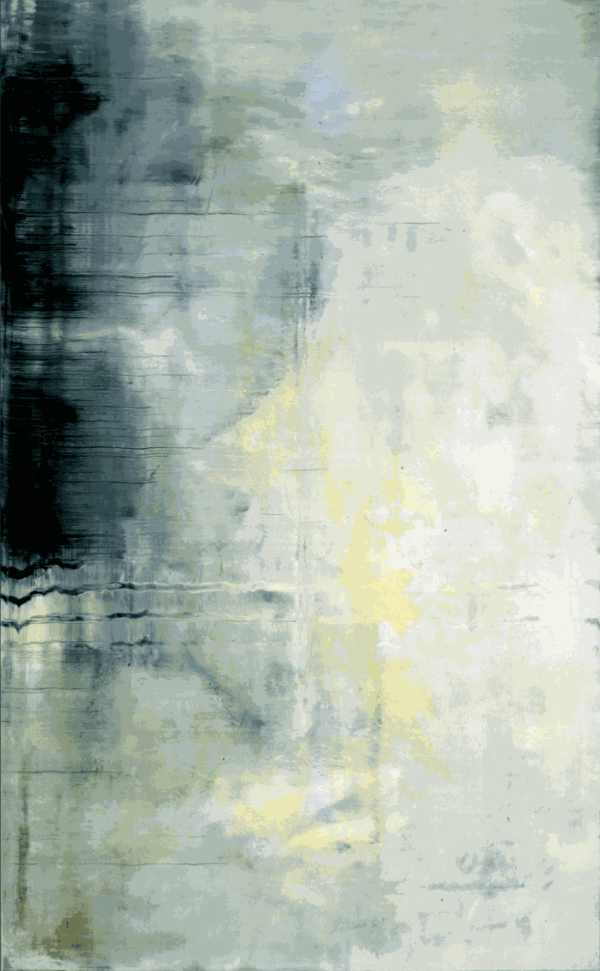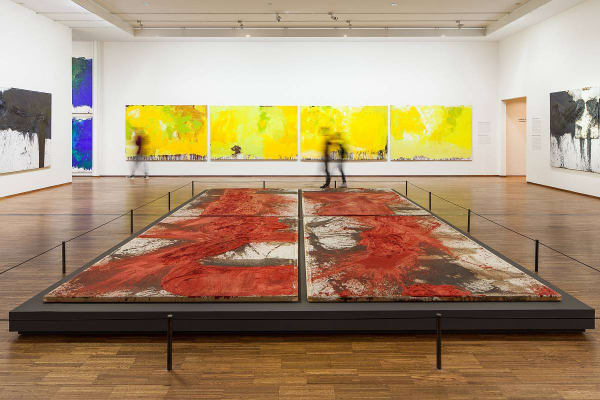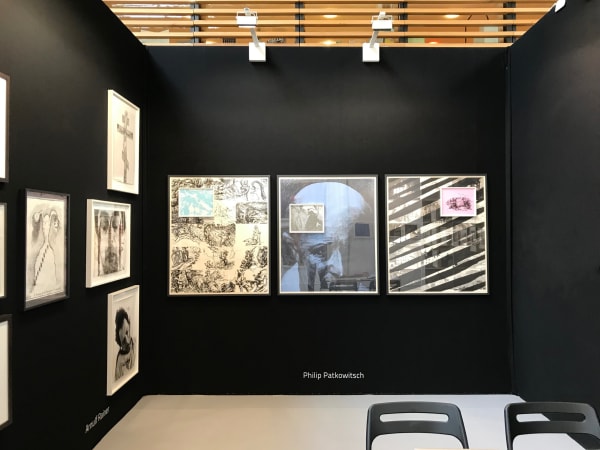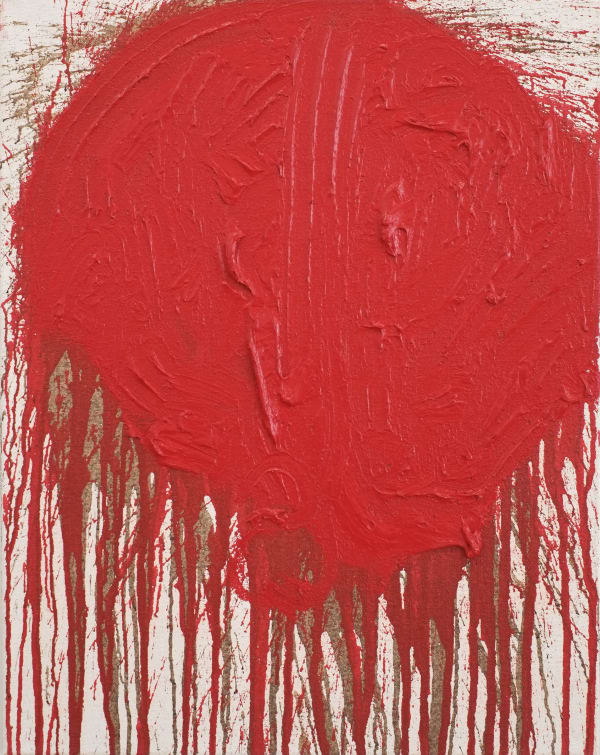"I am a church painter without a church. And without religion."
Influenced by the philosopher Friedrich Nietzsche, Far Eastern philosophy, psychoanalysis, the spirit of the wine god Dionysus and the deep roots of Christian Catholicism, an oeuvre emerges that wants to reveal nothing but sensuality.
When Nitsch founded "Viennese Actionism" in 1962 together with his artist colleagues Mühl, Brus and Schwarzkolger, he laid the foundation for his later work. Today, his work encompasses music, theatre and drawing in addition to painting. His Orgien-Mysterien-Theater, which he created, picks up the viewer in the depths of himself. The world is grasped with all the senses: Smell, touch, hearing and looking go hand in hand and Nitsch himself directs all these senses to this day.
Initially despised as an enemy of the state and later awarded the Austrian Cross of Merit, Nitsch is now one of the most authentic people in the art world. His works testify to a power and an urgency for sublime admiration that can only be found in a few areas of art.
Hermann Nitsch lived and worked in Mistelbach, Austria
born 1938 in Vienna · died 2022 in Mistelbach
"My talent for drawing enabled me to study at the Graphic Teaching and Experimental Institute in Vienna. There I received a good basic artistic education. I developed from studying nature to abstract painting. I was also interested in poetry, theatre and classical music. I was fascinated by the Gesamtkunst approaches of Greek tragedy, Claudio Monteverdi, Richard Wagner, Richard Strauss, Claude Debussy, Alexander Scriabin, Wassily Kandisky and Arnold Schoenberg. Philosophy, comparative religion and psychoanalysis, the mysticism of all religions interested me. I had intimate experiences with nature. After completing my studies in 1958, I became a graphic artist at the Technical Museum Vienna. There I moved into a large studio and was able to work a lot on the scores of the orgy-mystery theatre. I tried to write a 6-day original drama combining and bringing together ancient tragedies, Shakespeare, Faust, Kleist and Wagner. Informed by Freud and Jung, I wanted to incorporate redemption myths interpreted in depth psychology into my work.The actors were supposed to speak their roles. The language was full of sensual images. The book "the word poetry of o.m. theatre" illustrates this developmental phase of my work. Why should my audience be impressed only by the verbally quoted memories of sensual sensations. I ask my audience to directly experience sensually. There were instructions to taste, smell, see, hear and touch. Meat, willow and fruit were given to the audience to touch. Smells were emitted, incense and other liquids such as blood, urine, petrol, turpentine, ammonia, vinegar, hot water and milk (were) spilled in the theatre. This is how the orgy-mystery theatre came into being, through which language was transcended. Only real events were to be represented. The Orgy-Mystery Theatre was born."
(Hermann Nitsch)
COLLECTIONS (selection)
- Museum of Modern Art, New York
- Guggenheim Collection, New York
- Metropolitan Museum, New York
- Station Museum of Contemporary Art Houston, Texas
- Harvard University, Cambridge
- Tate Gallery, London
- Centre Georges Pompidou, Paris
- Stedelijk Museum, Amsterdam
- Museo Capodimonte, Neapel
- Museo d‘arte della città di Ravenna
- Museum Ludwig, Cologne
- Museum Brandhorst, Munich
- Kunstsammlung Nordrhein-Westfalen, Dusseldorf
- Kunsthalle Hamburg
- Kunstmuseum Bern
- Kunstmuseum Winterthur
- Albertina, Vienna
- Belvedere, Vienna
- MUMOK, Vienna
- Ferdinandeum, Innsbruck
- LENTOS, Linz
- Rupertinum, Salzburg
-

Sommer 2024
Mario Dilitz versus Malerei 13 Jul - 24 Aug 2024 bechter kastowsky gallery. SchaanWe are changing Mario Dilitz's previous exhibition: we are assigning paintings to individual sculptures and thus complementing the three-dimensional figure with the two-dimensional image.Read more -

Welcome 2023
group exhibition 21 Jan - 4 Mar 2023 bechter kastowsky gallery. Schaanwe start the year with a great selection of works by our artistsRead more -

Hermannn Nitsch
19 Feb - 16 May 2020 bechter kastowsky gallery. SchaanRead more
-

Museum Angerlehner. Collector`s Choice. Angerlehner. Löw-Radeschnig
with works by Constantin Luser, Hermann Nitsch, Hubert Scheibl, Martin Schnur and others 9 Nov 2024 - 30 Mar 2025With ‘Collector's Choice | Angerlehner x Löw-Radeschnig’, the Museum Angerlehner presents a unique selection of artworks from the renowned private art collections of Heinz J....Read more -

Colossal. Painting On A Grand Scale. Lower Belvedere. Vienna
with works by Hubert Scheibl, Hermann Nitsch, Jakob Gasteiger, Herbert Brandl and others 22 Jun - 27 Aug 2023It requires confidence, skill, imagination, and courage for an artist to tackle a huge canvas. The results are mostly major works of art: impressive, spectacular...Read more -

NITSCH. Spaces of Color
Albertina Vienna 17 May - 11 Aug 2019For Hermann Nitsch , painting is one of the disciplines of his Orgien Mysterien Theater. It is deeply anchored in actionism, performance, in multimedia. Painting...Read more
-

STAGE BREGENZ 2024
Contemporary Fair / Art / Design 22 - 25 Feb 2024STAGE Bregenz is a meeting place for a broad art and culture audience and at the same time a stage for the diverse interactions of...Read more -

Drawing Now Paris 2019
Gunter Brus, Hermann Nitsch, Philip Patkowitsch, Arnulf Rainer 28 - 31 Mar 2019Drawing Now Paris 2019Read more










